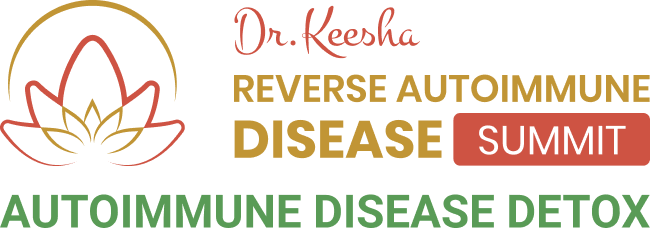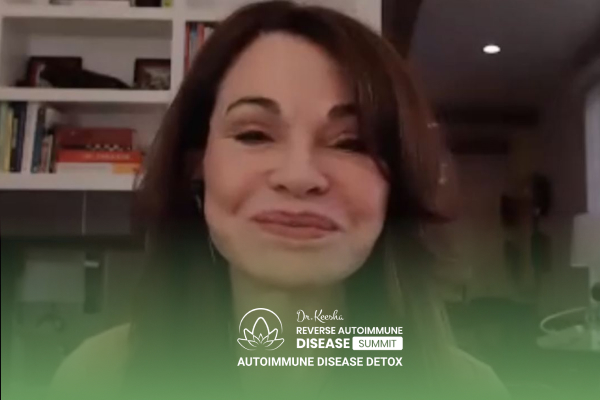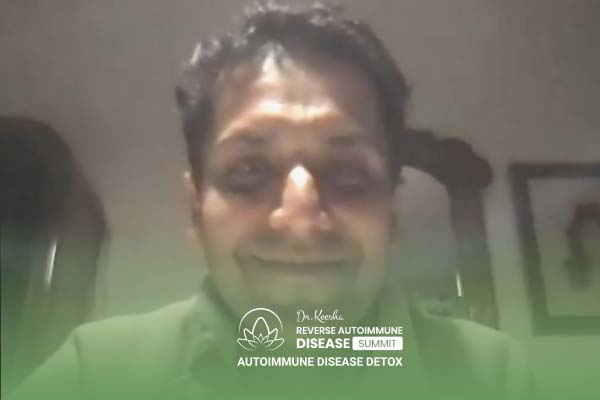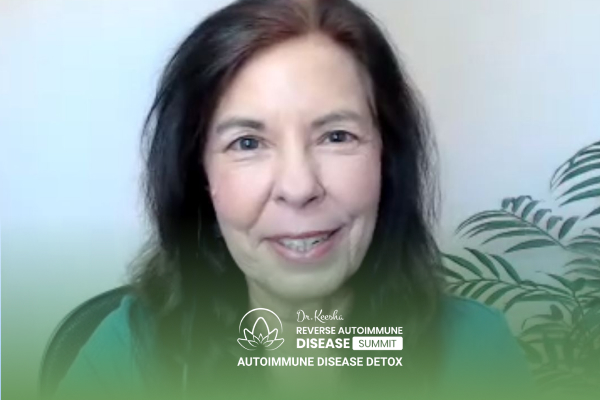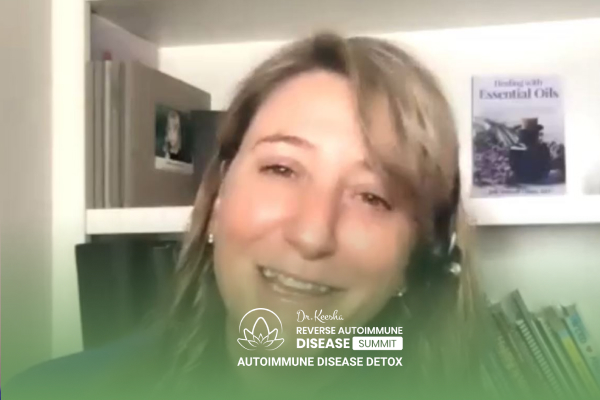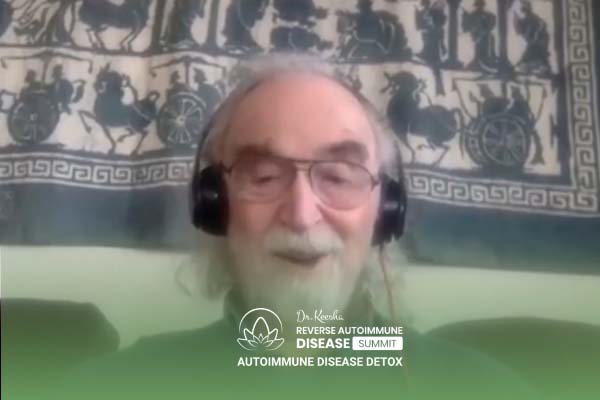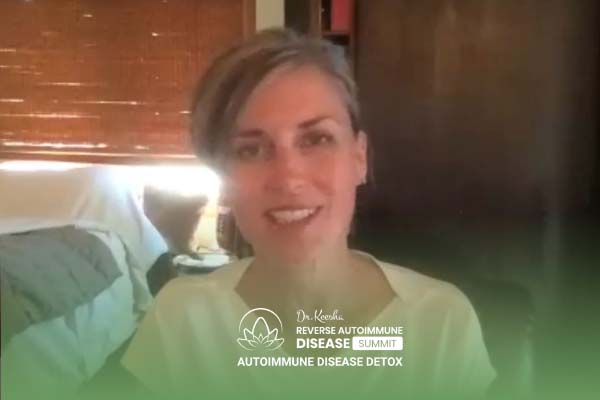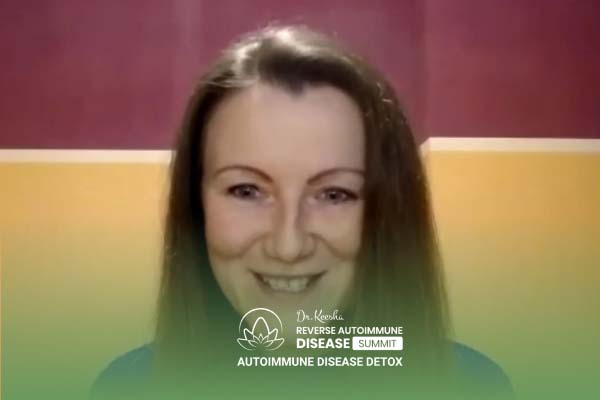Join the discussion below
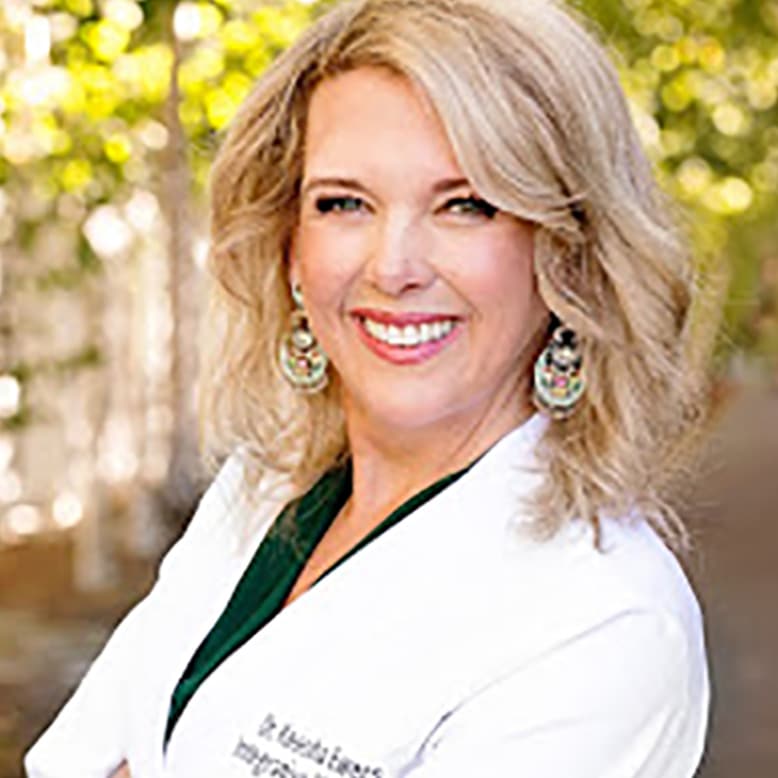
Keesha Ewers, PhD, ARNP-FNP-C, AAP, IFM-C
Dr. Keesha Ewers is an integrative medicine expert, Doctor of Sexology, Family Practice ARNP, Psychotherapist, herbalist, is board certified in functional medicine and Ayurvedic medicine, and is the founder and medical director of the Academy for Integrative Medicine Health Coach Certification Program. Dr. Keesha has been in the medical field... Read More

Donna Gates, M.Ed., ABAAHP, is the international best-selling author of The Body Ecology Diet: Recovering Your Health and Rebuilding Your Immunity, The Body Ecology Guide to Growing Younger: Anti-Aging Wisdom for Every Generation, and Stevia: Cooking with Nature’s Calorie-Free Sweetener. An Advanced Fellow with the American Academy of Anti-Aging Medicine, she is on... Read More
Keesha Ewers, PhD, ARNP-FNP-C, AAP, IFM-C
Welcome back to the Reverse Auto Immune disease summit series, everybody. I’m Dr. Keesha Ewers. You are joining me for the fourth iteration of the reverse autoimmune disease summit series. The auto-immune detox and I’m so delighted to bring probably somebody that doesn’t need introduction to you, but a good friend and colleague Donna Gates, M.ED., ABAAHP who is the international best-selling author of “The Body, Ecology Diet, Recovering Your Health and Rebuilding Your Immunity” and “The Body Ecology Guide “To Growing Younger Anti-Ageing Wisdom “For Every Generation.” For the last 25 years, she’s been on a mission to change the way the world eats. Her first book, “The Body Ecology Diet,” introduced the world to a sugar-free gluten-free, casein-free and probiotic rich diet in a way of life that’s now followed by tens of thousands of people around the world. The diet grew in popularity initially by word of mouth. And all these years later still stands the test of time. Welcome to this summit series Donna.
Donna Gates, M.ED., ABAAHP
I was just sitting here thinking, I hope you don’t read that whole bio there’s so much there and I didn’t write it by the way, so.
Keesha Ewers, PhD, ARNP-FNP-C, AAP, IFM-C
Well I love to pick out, that very first part. And then when I hear people introduce me too I think we can talk about all of this, right? And so, some of the things that are in your bio are important ’cause they’re things that you’ve done, but I wanna weave it into what we’re talking about. So one of the things that, you’ve completed an advanced fellowship with the American Academy of Anti-aging Medicine. And one of the things that has always been very true about you is that you are aging incredibly gracefully. And so, you walk your talk and have.
Donna Gates, M.ED., ABAAHP
I do, you too. I think you’re gonna see a whole lot of us looking very very different than whatever we are. 50, 60, 70, 80, that I’m positive that we are not supposed to age the way we have been aging. And it wasn’t that long ago when people died, they were old and they died in their mid forties. So now somebody, one of the teachers at A4M told me that, the new age for a woman today, that reaches a certain her fifties and she doesn’t have cancer or cardiovascular disease obesity, the new age is expected lifespan is 105. So even though I’m 74–
Keesha Ewers, PhD, ARNP-FNP-C, AAP, IFM-C
Well I’m 56 and I don’t have any of those issues so maybe that’s going to be true.
Donna Gates, M.ED., ABAAHP
It’s kind of interesting to think you have another 50 years and I’ve got another 25 or 30 years actually, what are we gonna do? What can we do next?
Keesha Ewers, PhD, ARNP-FNP-C, AAP, IFM-C
Right. So go ahead and tell everybody your age. ‘Cause it kinda got blown underneath us talking over each other. And I want people to really hear you say how old you are.
Donna Gates, M.ED., ABAAHP
Well, I’m 74 and I used to be really really sick. Once a time I wish I had the knowledge and the tools that I have today when I was 30, for example. So I’m actually healthier. I certainly don’t look the same, your face gets longer or you lose your baby fat and you change but the thing is what’s better is that my my health is actually way better than it was when I was young.
Keesha Ewers, PhD, ARNP-FNP-C, AAP, IFM-C
Not really that but you also have wisdom.
Donna Gates, M.ED., ABAAHP
Oh yeah and I wouldn’t trade that for anything. I would, at this age you kind of go back and wonder, I mean you wish you could do many things over again for sure, but it’s, I think it takes living a long time to have the wisdom. So that’s another good reason for living a long time. Imagine how much wisdom I’ll have in 30 more years and you’ll have in 50 more years
Keesha Ewers, PhD, ARNP-FNP-C, AAP, IFM-C
This is why I like getting older actually. My birthday was just last month and you know when I turned 56, I thought, okay, when I look back at where I was 30 at 30 years of age when I was diagnosed with rheumatoid arthritis, I just look at that woman, that version of myself and I go, Oh sweetie, you are operating with the level of skills you had at that age. But there was so much more that you’re going to learn. And then I think about my 86 year old version of myself looking at my 56 year old version going, Oh sweetie you were operating with the skill level you had been but there’s so much more to learn. And it just makes it really fun for me to age, because of that.
Donna Gates, M.ED., ABAAHP
Yeah and other people that are centenarians or more than centenarians, they say that they have a kind of, they don’t feel time passing. They’re not aware of a number. It doesn’t mean anything to them. So that’s probably a good thing too, mentally you’re not feeling old.
Keesha Ewers, PhD, ARNP-FNP-C, AAP, IFM-C
Right. Well, let’s talk a little bit about auto-immune disease, as a condition and maybe lay out a landscape for what’s going on as we launch into this next part of how to get your microbiome, how happy and what the candida auto-immune disease connection is.
Donna Gates, M.ED., ABAAHP
Well, I was glad that you wanted to talk about that because I’ve started talking about it and wrote a book with a the diet on how to get over it. Maybe close to 30 years ago now but all these years I’ve watched how people know what it is. They know there’s such a thing as candidiasis, there’s a yeast infection, but they don’t really really get how serious it is. And years ago I met Dr. William Crook when he had just brought his book out called “The Yeast Connection.” And we sat outside on his wall by a fountain that I love. And he said, we don’t think meaning he and Doctor Truss, Orian Truss, we don’t think there’s a cure for this. And in my naivety I was like maybe 37 or forties or something. But anyway, he, I thought I was sure there has to be, I’ve learned all this stuff in the last 10 years or so, I’m gonna find the cure. Well, I will say fast forward today, that there is no cure. I would agree with him. It’s one of those many infections that’s in our body that is really causing a lot of problems. And there’s a… And so I think most healthcare professionals even though they know about it, don’t really understand it and they don’t realize how critical it is to deal with it to at least get the, you can’t cure it but your immune system can conquer it. And that’s the goal.
Keesha Ewers, PhD, ARNP-FNP-C, AAP, IFM-C
So the conquering, I’m going to stick into the same lexicon as what I call reversing autoimmune disease. You’re not curing it. And I make that distinction, Dr. Tom O’Bryan does too, because your genetics are still there. The propensity that you have towards the expression of those genetics that can then be activated based on certain, environmental factors and also internal factors. And so, I always say trauma the way you manage your stress, your toxic load and your gut condition will all activate, what’s going on going on genetically and those genetics aren’t going away. You’re just expressing them differently. So I could get rheumatoid arthritis back. If I so chose probably within about six months I could really do it.
Donna Gates, M.ED., ABAAHP
Same with candidiasis. I took antibiotics for a long, long time ruined in my gut. I was in so much pain. I didn’t even like to eat. But I’m very well aware that if I just went out and eat like normal people, I would be a mess in no time at all. And who knows, what else would start going wrong? I don’t have any pain in my body and everything seems to be working perfectly, but it wouldn’t be rather quickly because one thing that has happened with time, your DNA does get damaged over time. So if you can damage your DNA rather rapidly and I think, I believe that if you’re say in your seventh decade of life that that damage is gonna show up faster than it would if you were damaging two or 20, even. So I’m sure I would, the aging would really start quickly.
Keesha Ewers, PhD, ARNP-FNP-C, AAP, IFM-C
So this isn’t a function of growing older but a function of your body getting worn out from having to rob Peter to pay Paul, right? Your body’s trying to maintain homeostasis and it will borrow from different, parts of different systems, until finally it can’t do that anymore. And that’s when you, I mean, for me, my RA, when I was 30 it felt like it was all of a sudden but it was not and I looked through my early childhood of frequent UTIs and then in my adolescence of frequent, repeated strep infections in my throat and multiple antibiotic use, right? And then Acutane at the end of that for acne.
Donna Gates, M.ED., ABAAHP
I’d say my story.
Keesha Ewers, PhD, ARNP-FNP-C, AAP, IFM-C
Yeah and then beginning to run marathons in my twenties and popping Advil for pain, of course, by 30 I had rheumatoid arthritis. This wasn’t an all of a sudden kind of thing at all.
Donna Gates, M.ED., ABAAHP
Well, I’ve been really interested in auto immune conditions for a long time, but I’m super interested in inflammation as everybody is. I mean, that’s the, everyone in functional medicine agrees that underlying anything you have, there’s always gonna be a lot of inflammation. And when you have a yeast infection where you use that one. ‘Cause I really like to explain where yeast coming from today I know something that other people don’t even know that I’d like to talk about, but so you have a yeast infection and your immune system is really trying to keep it under control. And so just like any infection that comes in your body, a COVID virus, or Epstein-Barr herpes, you might have a strong enough immune system where you’re not noticing symptoms yet but that inflammation is definitely playing habit and it’s damaging. So what’s happened is that I think the long haulers are gonna be an excellent example of this. These young people they’re in their thirties and forties, do get the COVID. And they were healthy they think before that, that’s questionable but they felt healthy.
Keesha Ewers, PhD, ARNP-FNP-C, AAP, IFM-C
95% of Americans have Epstein-Barr everybody. So really locking in what Donna’s saying right here about the underlying burden right? Yeah.
Donna Gates, M.ED., ABAAHP
Yes and so they get this trigger basically. And the immune system initially does what it’s supposed to do. It starts attacking, killing the virus, but at the same time, the other part of the immune system the memory part in it’s sense has awakened and you’re already just the first part that goes in and kills that virus is also let’s say friendly fire, like a soldier. It gets killed in the line of, by his own people because that inflammation is damaging all this other tissue and these organs all around. And then the immune system moves into this other stage. And it really never that information really never turns off. They’re calling it unresolved inflammation. So I started following somebody years ago, Charles Sirham and his team. And they were looking at this unresolved inflammation.
They also found that in fish oil, which I think everybody knows is excellent for helping with inflammation, but in the fish oil are these tiny little molecules resolvents and they were able to extract those and pull them out and then actually create a supplement and give that to people. And it was interesting ’cause most of the people in the study were women ’cause women are much more likely to have autoimmune conditions of course. And you had all kinds of conditions, maybe weight gain was there a problem or hormone imbalances or arthritis or whatever, but no matter what, they had all of the things resolved with the resolvents, with this particular product and that it took a long time and it’s expensive but it does tell you that what we really need to be going after is the inflammation.
In order to go after the inflammation, you’ve got to go after the infection that’s there. And just like you said, you said that Epstein-Barr everybody has Epstein-Barr. So you get something like, COVID you think you got over it. You might not even have much of a reaction to it, but these, the immune system’s been real busy, fighting COVID infectious virus. And now these other infections are beginning to wake up because the blood has become very acidic, perfect environment for the mole to wake up. And I really think that what we’re gonna start calling the long haulers is a new autoimmune condition. They’ve got this ongoing inflammation and now all of the symptoms that they have extreme fatigue, gut problems, headaches, because they know that the COVID actually affected the nervous system. And a lot of the problems they have are related to that COVID-19 is like SARS. SARS I know it will definitely attack the nervous system and you still can find SARS in the nervous system. So these essentially–
Keesha Ewers, PhD, ARNP-FNP-C, AAP, IFM-C
This is the same thing that’s happened with the lyme too. So a chronic Lyme is now considered auto-immune because of the same exact thing, right? This molecular mimicry happens. And then we start to get an auto immune component to it.
Donna Gates, M.ED., ABAAHP
So autism is considered an auto immune condition because there is inflammation going on. And this is where I started to do a lot of digging. One of the things I discovered, so you have a child who’s two or three years old but is that where autism began? So I started to go back into the time in the womb and see what I could figure out there. And I didn’t know, I love Nutrogenomix it’s one of my favorite topics to study, but that wasn’t I didn’t know anything about it back then. So I didn’t go that far, but I was looking for microorganisms that might be in the amniotic fluid. And indeed there were some that were found there. But so there definitely things are always happening in the womb, but I don’t think that that’s at all what, this is my theory and I wish people would start researching it.
But what’s happening is the mother, young women today have belonged to a generation, if you’re like 55 or 60, under that age, you live in a generation that was given a lot to of antibiotics. And therefore you would have a yeast infection. Now it might be under control ’cause you’re pretty healthy at 20, 30, 38, whatever when you get pregnant, but the immune system is suppressed during pregnancy so that the mother’s baby won’t reject the new fetus and all. So there’s one thing going on is the mother’s immune system is suppressed and then her estrogen, progesterone and cortisol and sugar are all going up to build that baby inside of her.
So if she has a latent yeast infection or she isn’t latent, she knew, she’s had a yeast infection it’s now gonna become much more acute during the pregnancy. And there’s no doubt that we can pass our infections onto our baby. And Hippocrates years long ago, talked about babies that had thresh in their mouth. So they didn’t have antibiotics. It had to be coming from another source basically. And that would have been from a mother for some reason back in those days, had a yeast infection, got pregnant and pass it on to her baby. So I very strongly that what it is.
Keesha Ewers, PhD, ARNP-FNP-C, AAP, IFM-C
It was a lot of wine instead of water back in those days. And it makes me curious.
Donna Gates, M.ED., ABAAHP
Oh yeah that’s true. The water wasn’t clean.
Keesha Ewers, PhD, ARNP-FNP-C, AAP, IFM-C
Right and so there was a lot of drinking of wine as water. So that makes me curious of yeah.
Donna Gates, M.ED., ABAAHP
Exactly. Gosh, I don’t know. I really have not sat there and thought about that part of it, but I do know that it’s extremely critical thing to understand if you’re gonna get your child well from, you just cure, but I know watch our kids and I grew up began recovering and they were the first ones to recover. What were we doing? Fixing the gut with fermented foods, bringing that yeast infection under control with a diet that was gluten-free, sugar-free, casein-free had these probiotic foods in there and building your immune system and then because of the gut brain connection, gut getting healthier, brain getting healthier. And so I was lecturing at a conference a mind conference in Australia years ago and I mentioned that, about this whole thing. And then I was able to lecture for two whole days and somebody, two different times or two days. And some of the moms came up to me and said our doctors, there were autism docs, they’re over in the corner and they are talking about you. And they said there’s no way the brain can become infected. That’s actually what people believe then it wasn’t even that long ago–
Keesha Ewers, PhD, ARNP-FNP-C, AAP, IFM-C
It’s not that long ago that has been debunked, yeah.
Donna Gates, M.ED., ABAAHP
Yeah that’s what they actually believed in. So unfortunately I was able to go back to my room and just look up a bunch of stuff in the next day or two, I had another talk and I said, what about meningitis and encephalitis? Those are infections in the brain. This is what I believe that the brain is infected. Well within a year and Martha Herbert at Harvard had done the research to show that the brain of these children have inflammation. Then yes I’d say Autism is an auto-immune condition but what’s driving it is inflammation caused by an infection or a number of infections. So to me, that’s what auto-immunity is. And then if you work to get rid of the inflammation and the infection, and detoxify and all that then you are definitely gonna see a reversal, a quieting down of your symptoms.
Now like Dr. Datis Corezian says this, he doesn’t think he can ever get rid of an autoimmune condition than it waxes and wanes but that’s because many of these intruders in the body they don’t ever go away. Yeast don’t ever go away. They change back and forth. They can, become very clever at changing shape and they can become completely harmless. And the immune system doesn’t pay any attention to them. They’re even perhaps, commensal contributing to the community, but then very easily they can change into the very dangerous form work tentacles but they do secrete toxins. And one of the toxins that they secrete gliotoxin, which mold also… Mold and fungus flung. Mold and fungi they’re both fungus. And they both secrete gliotoxin. And gliotoxin suppresses the immune system.
So that’s one way it’s one reason why it’s so hard to get the immune system to ever get enough energy, to get rid of these permanently. In the meantime, other infections in the body like Epstein-Barr, or they’re getting to run wild too. And there are certain things that trigger it, like a lot of stress and so on and a really bad diet for a while. A lot of things keep triggering this over and over again.
So they never ever go away. Herpes doesn’t go away. Epstein-Barr doesn’t go away.And I’m just kind of watching this, what researchers are finding out about the COVID-19 does it really go away? I mean, what long-term effects is that having, at least unresolved inflammation and therefore these young people are gonna end up, they have forums all over the internet trying to figure out, reporting actually all the time what’s going on with them, but nobody’s really helping them from what I can tell.
Keesha Ewers, PhD, ARNP-FNP-C, AAP, IFM-C
Not yet.
Donna Gates, M.ED., ABAAHP
So to me it’s the new autoimmune condition, the latest of many.
Keesha Ewers, PhD, ARNP-FNP-C, AAP, IFM-C
Yeah. I remember after, Oh, it was probably about six months ago my husband said, “I think you could be really helpful “to the long hauler community is sounding like “it’s turning into an auto-immune issue.” And I went, “Wow, you were paying attention.”
Donna Gates, M.ED., ABAAHP
Yeah I agree with him. See, I thought that was my idea but he’s right there in the same page.
Keesha Ewers, PhD, ARNP-FNP-C, AAP, IFM-C
So it’s just the observation of, Oh, this anything that has that chronicity to it, right? You have to start thinking of autoimmune, you have to start thinking like mimicry and what are these organisms that were. I mean, the thing of it is is we’re outnumbered ourselves, by all of the microbes that we, that inhabit us and that inhabit this planet. And we’re just sort of always interacting, right? And what we wanna do is maintain a healthy harmonious flow with them that when we have some of these chronic infections that cause inflammation, then you’re not going to have that
Donna Gates, M.ED., ABAAHP
Well and then of course genes are supposed to be playing a role in this. And there’s quite a few genes that are playing a role for example, interleukin C-reactive protein, TNF alpha interleukin six. And so on. Those are genes we’ve got variants there. And those genes aren’t really, they’re kind of mean like they’re, if you become infected, they just run away like fire, you can’t control them because you have those variants. So that’s another factor also, like irritable bowel disease is another auto immune condition. And what are the genes I love to check for, I think every practitioner should know this is FUT2. Now that gene is responsible for producing B12 as other genes are but it’s also a kind of a blood sugar gene. Like I’m a blood type, A are you an A? B?
Keesha Ewers, PhD, ARNP-FNP-C, AAP, IFM-C
I’m a B positive.
Donna Gates, M.ED., ABAAHP
I can almost guess that. Yeah. So you’ll be secreting creating your B sugar, which is different from my A sugar into certain places like your mouth, your gut lining. If we were breastfeeding, we would be secreting that sugar into our breast milk, for example, tears. So yeah. Saliva, tears, your skin, your sweat. So the bacteria that live there they’re getting fed by the sugar in the blood, different types of sugar. Well, if you’ve got a FUT2 variant, then you’re not feeding those bacteria and in all those places. So imagine if you’re not feeding your gut bacteria, and the bacteria of most importance is the bifidus what the very beginning of life bifidus, is what it’s all about in there. If it’s infantis and then these other strains start showing up for six weeks. There’s almost nothing really prominent in there, but the bifidus. And so what babies picked up from the mother and the outside world and all, but mostly it’s bifidus. So now for the very beginning of life you’re not feeding the bifidus and you’re gonna start off with a weakness, a risk factor for irritable bowel disease or other some type of gut problems too. So genes play a role. That’s an example of a good one.
Keesha Ewers, PhD, ARNP-FNP-C, AAP, IFM-C
We do genetic testing on a hundred percent of my patients. And FUT2 is often a block of snips that will either be yellow or red for my auto-immune patients. ‘Cause that’s who usually sees me as people with auto-immunity. So, this is an important one what you’re talking about. Because the thing of it is though, is it’s what you’re wired for. So then it means I always call it like a Pirate’s treasure map where X marks the spot where we need to dig a little deeper. So then that points to, okay what do we need to be watching for for you as an individual, right? Because of this wiring that has the potential problem.
Donna Gates, M.ED., ABAAHP
And then of course bifidus is always an important bacteria throughout life but as people get older there is no bifidus in their gut. So that, I think it’s one of the most important ones to supplement. I don’t think you necessarily have to supplement lactobacillus because they’re easily obtained in fermented foods, fermented vegetables in particular in kimchi and what I teach people to eat, but they’re not bifidus. And bifidus is very very fragile, easily destroyed. And yeah, so it’s just, there’s so much to say about the gut, the role the gut is playing in the whole auto immune condition, but you need diversity. You need to have a lot of different type of bacteria in there. ‘Cause that’s gonna be your immune system and the stronger you make your immune system, the better chance you have of keeping all these problem child’s the Epstein-Barr strong immune system can keep them under control and quieted down. So they’re not out there raging and causing pain somewhere in the body.
Keesha Ewers, PhD, ARNP-FNP-C, AAP, IFM-C
So what does, some of the plants that inhabit our planet have anti-nutrients attached to them. So predators can’t get ahold of them, right? So histamines and oxalates, what’s their role in this?
Donna Gates, M.ED., ABAAHP
Well oxicism to me the most, the one you should actually be careful not to eat. I think that a histamine problem, I know there’s all kinds of mass cell disorders and I mean different things that are histamine related. But to me, I don’t like to get stopped there. I think below all of those is gut dysbiosis. So that’s really what’s going on. If you eat fermented vegetables with a lot of electric bacillus and particularly the way I teach people to add extra starter, you’re gonna get lactobacillus is degrading, histamine. It bumps up the power of the GAO enzyme in the gut. So they can solve a lot of problems for people.
But the oxalates are in only in the plant world. You won’t find them in meat or chicken or fish or eggs or dairy or anything. It’s just in plants. And some plants don’t have large amount of oxalates or low oxalates where some are extremely high. And I think that, earlier in an earlier time, before the era of antibiotics, people naturally carry a microbe in their gut called oxalobacter formigenes and he ate oxalates. That’s the only thing he did in there was eat all the oxalates that might be in food that you’re eating. And then we started, bombarding or bombing the gut and he never came back. He’s one of the missing microbes. Now he started eating foods with oxalates in them like spinach, sweet potato.
Keesha Ewers, PhD, ARNP-FNP-C, AAP, IFM-C
Staffing, those smoothies full of spinach, right?
Donna Gates, M.ED., ABAAHP
And also look how popular chocolate is and almond milk and cashew milk in your smoothie with your spinach, beats are, everybody’s raving over beats and beats do have all food has a front and a back. I always try to teach people that look for the good look for the bad. They have both. So beats make nitric oxide. They give you more energy but they’re super high in oxalates. Now, if you, for a minute, by the way you can get rid of the oxalates ’cause the microbes in their beats eat up the oxalates. So you can do things to try to get around the oxalates. But here’s why I think they become an even more of a problem today for people is that yeast have the genes for making oxalates.
So even if you’re, you’ve avoided these really high oxalate foods and not run through a lot of them again there’s sweet potato, spinach, Swiss chard, nuts and seeds, which also have another plant poison called phytic acid. And they’re supposed to be soaked, but nobody’s doing that. They just eat them right out of the bag. So they’re very, very high in Oxalates. Not all of them like flax is very low while chia is incredibly high. And also depending on where the nut is grown like in the cons and New Zealand are low but in other places they test high. So ultimately what I’m hoping someday happens is that some of the nutmeg, people that are growing, I have a friend who’s growing almonds where they’re grown in Jamaica, but he, gets them in no, it’s brand new.
He just started the business. And so I can’t wait to test those because things are going in Jamaica in that soil are gonna have a different oxalate content than maybe California almonds or something. So we kind of have to test I just recently test the Calla Fria oat milk. ’cause I thought, okay that might be a better choice for people than cashew milk and it is actually low in oxalates. So I send them off to center but anyway, the yeast are making Oxalates too. So imagine if you’re eating them and you have the yeast infection and they’re making them now people have real real serious problem. And they’re like little tiny shards of glass microscopic of course we can’t see them but they tear up the insects mouth. What they do is they get into the body and they start to basically get into the tissue, muscles, organs, kidneys, for example. And they can start and the body starts protecting itself by forming these stones.
Keesha Ewers, PhD, ARNP-FNP-C, AAP, IFM-C
We call them isolate crystals you guys.
Donna Gates, M.ED., ABAAHP
Yes, exactly. And then I have one study showing that 65% of them are going into the bones. Well, if you’re going in the bones, you’re not gonna see them in the bones like you would in your kidney stones or if you have all the ovadinia or something. So yes those are conditions that like diabetes, and cancer, you always have to be on a diet for somebody who has a yeast infection that is trying to conquer it and bring it under control.
Keesha Ewers, PhD, ARNP-FNP-C, AAP, IFM-C
This is a big one I’ve found for lichen to any of the different kinds of lichen.
Donna Gates, M.ED., ABAAHP
For example, what are you talking about—
Keesha Ewers, PhD, ARNP-FNP-C, AAP, IFM-C
Vaginal or internal oral?
Donna Gates, M.ED., ABAAHP
Yeah I did know that.
Keesha Ewers, PhD, ARNP-FNP-C, AAP, IFM-C
That oxalates are a big component with it which with an underlying candida problem. Let’s talk about some ways to, you said fermented vegetables will reduce oxalate content. I do wanna mention that if you juice a beat it also removes most of the oxalates. What you have leftover is a lot of sugar, so you have to juice other things, not fruit, please. So that, I mean I really love to have a little fruit juice in the morning. Not fruit juice, vegetable juice in the morning and then make sure I’m having my rest of my vegetables in different ways and protein and fat along with all of it.
Donna Gates, M.ED., ABAAHP
No, I always consider fermented vegetables, having some in the refrigerator an antidote because let’s say you do have a juice and it’s got fruit or stuff in it. And it wasn’t all your best thing for you to eat no fruit.
Keesha Ewers, PhD, ARNP-FNP-C, AAP, IFM-C
No fructose guys.
Donna Gates, M.ED., ABAAHP
No especially for yeast infections or anything, anything. But so, well sometimes, people say like, if you have a yeast infection put in 10% of something like pomegranate juice concentrate which is really sour with 90% vegetables and a little severe, or some kind of a sweetener because they won’t just eat the vegetables by themselves. So at 80, 20 ratio or a 10, 90 ratio is, like you’re moving away from the sugar. But anyway, Oh gosh, what was I gonna say?
Keesha Ewers, PhD, ARNP-FNP-C, AAP, IFM-C
Fermenting.
Donna Gates, M.ED., ABAAHP
Eating a spoon full or two of fermented vegetables afterwards. Now you’ve got the stomach, the juice is in your stomach but the vegetables are done in there too. And they start eating the microbes. They love that sugar. So they’ll eat it up for you. So it doesn’t get a chance to go into your body. What I think would be really interesting because there’s more of these variables coming out where you can, the glucose continuous glucose monitor where you can eat something and it will tell you what happens to your blood sugar. I think that if people did that, they would find that their blood sugar stays very stable. I mean, not say go out and eat all chocolate chip cookies, but no, I do think that it’s almost like an antidote, these fermented foods can be used as an antidote, the veggies.
Keesha Ewers, PhD, ARNP-FNP-C, AAP, IFM-C
So I know not all fermented foods are created the same. This is something that you like to talk about as some of the myths and misunderstandings. And I would love to have you disabuse us of some of the myths of fermented vegetables.
Donna Gates, M.ED., ABAAHP
Well, one thing that bothers me is when people say, well the fermented foods are good for you, but they don’t get down and get colonized into. They don’t stay in the microbiome. Well, they don’t stay there like most bacteria, very few do. Most of them are in the stool and they’re gonna be leaving every time I go to the bathroom. Some will colonize but most of the bacteria are transient but while they’re there for the two or three weeks or whatever, they do really important things. They make B vitamins and vitamin K and they look around and they find pathogens and eggs and larva that you might have on some vegetables you ate.
And they consume those like caviar. And they just so many important things while they’re in there. So it doesn’t matter if they’re not, you’re not eating them just colonized, but you’re always eating them ’cause you always want new ones. You always want to have a gut that has these great wonderful microbes in them. So that’s one thing I want people to understand. And then the other thing is, is that not all of them are the same. So I know that, in stores, they have these cases that are loaded with kombucha but kombucha is in the same category with wine and beer. So wild fermentation it has a lot of wild yeast in it and if you have yeast in your body, your body is already doing its best to try to keep that yeast under control and now you’re adding more yeast.
So many people notice that they can’t drink kombucha anyway or they will get a really strong histamine reaction. That is one time when I tell people, hold off in the fermented vegetables, if you do get like a lot of gas and bloating at first, because first of all they’re going in there and they’re the microbes and they’re changing the environment. And that’s kind of like if you painted your house, your room in your house, so it look like a mess until you get it finished and put it all back in order again. So there will be that often, but if you constantly find yourself bloating, if you do have fermented foods, then it’s almost like a diagnosis that you might very well have SIBO.
Keesha Ewers, PhD, ARNP-FNP-C, AAP, IFM-C
All intestinal, bacterial overgrowth yeah.
Donna Gates, M.ED., ABAAHP
Yes exactly. So hold off, deal with that and get that wiped out. And either fungus or the bacteria, whatever most of the time, it’s, E-coli, eclampsia or E-coli. We have a product, it’s a phage really it’s called echo aphasia. And what it does is it hates has a deadly killer of E-coli. So you take it and get it down into your gut and it starts to find the E-coli and get into that cell and multiply and blow it up. And when it blows it up, all the nutrients that were in the E-coli actually become a prebiotic for it’s a prebiotic because those nutrients are now available for the other microbes around there in that neighborhood to eat. But in the meantime, when it blows up, it’s just dispersed out into the environment. Trillions of phages, they’re eating the E-coli anywhere. So it goes around looking for many more E-coli to destroy.
It’s considered the worst killer on the planet. The most dangerous killer on the planet is that phage. They’re good phages, and they’re bad phages. So there’s some like everything else has good bacteria bad bacteria, but these good phages are viruses that are so tiny they can move right into the cell and they kill it and then move around and find more to kill until they’re gone. So I think that anybody with SIBO they should absolutely take a phage for about two weeks. It doesn’t take long for them to kill everything in there. So let’s say now you’ve done that and you’ve avoided the foods that are that’s why the Monash university FODMAP can be very beneficial in the beginning. So you do that. And then you don’t wanna just for the rest of your life’s stay with that limited diet. Now you wanna slowly–
Keesha Ewers, PhD, ARNP-FNP-C, AAP, IFM-C
Okay, wait just a second. Really let that land everybody. You don’t want to for the rest of your life, stay on that limited diet. I’ve seen people put themselves on a low FODMAP diet, not inform me. I actually had a patient that this happened to and then then put herself on a low histamine diet too. And then come to me in tears after I’d been working with her for six months and say, I have nothing I can eat. And I’m like, what do you mean? Right? What do you mean? Then I started finding out, Oh yeah, I read this and I read this and I sort of took myself off of all these things, please don’t do that you guys, as Dr. Donna say, it’s common, and it really does create a nutritional deficiency for you if you’re not doing it according to a method a lot of, a methodological structure that we’re talking about here.
Donna Gates, M.ED., ABAAHP
We know Keesha I always like to think that, well, how does nature do stuff? Anything that happens, nature has a step-by-step process, which is one of our principles in body ecology step-by-step. And at the very beginning of life, something’s happening inside your gut. That’s really important. We’re actually born in the world with a leaky gut but then we get this cluster because the gut is permeable. It often is permeable by the way. But that cluster is going in and immediately getting into the baby’s bloodstream to protect the baby because he’s been living inside this mostly sterile world not at all exposed to all the, things in the environment. And so nature’s already starting to take care of this baby. ’cause actually when you really start studying nature, the most important thing nature cares about is actually the next generation, conception and getting that baby into the world and getting that baby started.
So as soon as you realize your baby has all his fingers and toes the most important thing to do is start thinking, okay we have to get a healthy inner eco system in our baby right away. And so he’s strong and it will take months to do that. You don’t have an immune system yet when they’re born. So, you know I don’t know if this is controversial subject today but the idea of vaccinating babies at birth without an immune system doesn’t fit the model of the purpose of the vaccine, right? Yes. But anyway, looking at nature nature does things in a step-by-step way. And so if you’ve got a pathogen in your gut, kill it, just get rid of it. Don’t feed it, starve it out and so on. And then though you wanna start putting that inner ecosystem in place ’cause it is your immune system. And so if you’ve made fermented vegetables or if you won’t make them, you can go buy some at the health food store they’re very available today.
They weren’t years ago. No, you had to make them but just take the juice and put some in your mouth. We actually do that with our newborn babies. We’ll take the moms have been eating fermented vegetables to the pregnancy. Take a little dropper of the juice and put a little bit in the baby’s mouth. And they make a really funny face, but they never get colic. They grew up to be happy little kids that eat everything and they smile a lot and their brains’ well developed because their teeth development is great. They’re usually really precocious, because their gut brain thing is working. And so you wanna think that way too, don’t think I’ve got this, I’ve got SIBO or SIFO and I’m just gonna keep killing it. You wanna think also put this interactive system back in place ’cause ultimately that’s gonna prevent you from getting SIBO again. It’s reoccurring people get that over and over again.
Keesha Ewers, PhD, ARNP-FNP-C, AAP, IFM-C
Right. This has been so helpful. I so deeply appreciate you spending this time. Is there something that we have not talked about in the next couple of minutes that you wish we would have hit on that you just really wanna say about this connection?
Donna Gates, M.ED., ABAAHP
I made all these notes to myself. I know. I wanna show you this folder I have right here, so.
Keesha Ewers, PhD, ARNP-FNP-C, AAP, IFM-C
Consonant researcher right here you guys. Donna’s always researching
Donna Gates, M.ED., ABAAHP
No I did these ideas. And then I got looking and sure enough there’s research on anything you can think of but this isn’t my little folder here of some of the very latest things I just pulled up very recently. And this is an interesting study. They took these.
Keesha Ewers, PhD, ARNP-FNP-C, AAP, IFM-C
I’m here.
Donna Gates, M.ED., ABAAHP
Oh good okay. So this study right here shows that so they took these obese Korean women. So they’re obviously overweight and have metabolic syndrome and everything. And they started giving them, they’re Korean so they’re eating kimchi which true of all fermented foods. So what they found is that eating the fermented foods completely changed the gene expression of these women. The genes that are causing obesity and diabetes and heart conditions and all the in particular the things that we look at with, Oh, their levels, so what they were looking for is their levels of glucose and insulin, their triglycerides and their lipids. And they were looking at the inflammatory markers.
All of them worked well if they started eating the fermented kimchi. Then here’s one on fermented foods and neuroticism and social anxiety which we have a lot of today. Same thing that if you ate the fermented foods the social anxiety and everything vanished. Here’s one about deaths of COVID. There’s two studies on that. People that ate the fermented foods had a far lower risk of death. Now I might also throw in there that they’d probably many people eating them won’t even get covered ’cause they have a strong immune system. I mean, they might even be infected with it but they won’t have signs of it. And then here’s that one on oxalate level in beats being completely eliminated–
Keesha Ewers, PhD, ARNP-FNP-C, AAP, IFM-C
With fermentation.
Donna Gates, M.ED., ABAAHP
With fermentation and then what I said before is this does do those bacteria and those fermented foods make a difference in the gut or, ’cause honestly there’s a very famous dead person saying that right now. Well, this study is a whole big long article and help it’s called, does consumption of fermented foods modify the human gut microbiota. Well, you can probably guess the results. I wouldn’t have it here. Absolutely it modifies them. Tremendously and they have all this bacteria have their own genes. Every single one of them has their own set of genes. And we just have so many genes, 20,000 or so but they have every, one of them has their own set of genes. And they’re in there doing really important stuff with these genes. Absolutely they’re modifying what’s happening in the gut which just means it’s happening in every organ in the body, in your brain. The vagus nerve is connected to all these different organs, the lungs and the heart and the liver and spleen.
Keesha Ewers, PhD, ARNP-FNP-C, AAP, IFM-C
The immune system. Yeah.
Donna Gates, M.ED., ABAAHP
I mean So in one of the battle cries I think of functional medicine is first fix the gut. It’s not a bad place to start especially if you think you have an auto immune condition.
Keesha Ewers, PhD, ARNP-FNP-C, AAP, IFM-C
I so appreciate you. And thank you for sharing the research at the end there that you just pulled. I love that.
Donna Gates, M.ED., ABAAHP
Yeah. Well thank you for letting me have the time to do that. Keesha thank you very much for doing the summit. And I hope we are able to reach and help some people.
Keesha Ewers, PhD, ARNP-FNP-C, AAP, IFM-C
Yeah absolutely. And everybody Donna’s contact information is listed here and she has a free gift for you and we will have that attached also. And again, start with the gut. Your microbiota are making a huge difference in all of your reality. So thank you, until next time be well.
Downloads
